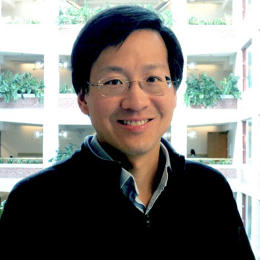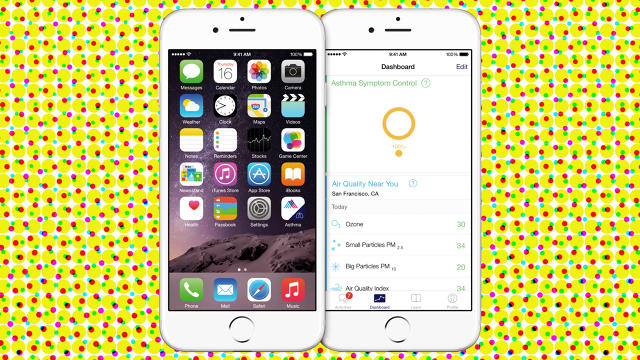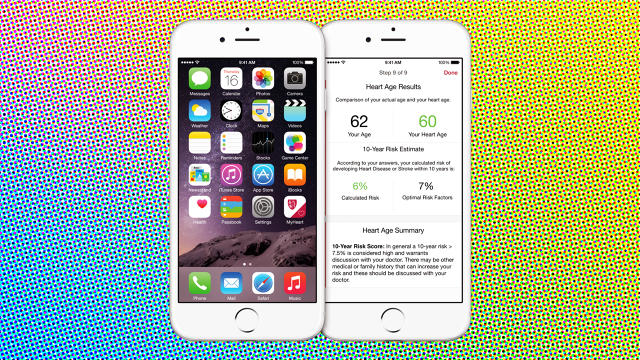How Apple Is Building An Ecosystem For Your Body
As it embarks on a mission to strap its products to your body, CEO Tim Cook says health could be the company’s “biggest” frontier.
When the lights dimmed in San Francisco’s Yerba Buena Center on March 9 and Apple CEO Tim Cook took the stage, most of the world’s attention was focused squarely on his wrist. But at least one person’s in the audience, a biology researcher named Stanley Shaw, wasn’t. “It was interesting to sit there among these other people who were primarily excited about the MacBook and the Apple Watch,” he said.

Shaw, an assistant professor at Harvard Medical School and a researcher at the MGH Center for Systems Biology, was thinking deeper than apps that let you, for instance, order a sandwich with a tap. He was focused on the potential of the internal gyroscopes, accelerometers, and GPS sensors in Apple’s mobile devices that can help patients, doctors, and researchers track the progression of conditions like heart disease, Parkinson’s, and asthma.
That potential was the basis of another launch that morning: ResearchKit, an open source iOS framework designed to give way to a panoply of apps for medical research and to manage the data those apps collect.
A follow-up to HealthKit, an iOS framework Apple debuted last year as a fitness- and health-oriented platform, ResearchKit aims to create a standard for designing research-based apps, turning any iPhone owner into a potential research subject. That could dramatically expand the size and lower the costs of health studies, helping to accelerate medical knowledge. “It really highlights the possibility of democratizing data around people’s health,” said Shaw, who advised Apple on the program and helped design one of its first apps.
The early numbers show a glimmer of that promise: Within just four days of its release, MyHeart Counts, a cardiovascular-focused ResearchKit app designed by the Stanford University School of Medicine, was downloaded 52,900 times in the U.S. and Canada, with an unprecedented 22,000 people also consenting to participate in the study. Typically, that kind of participation might require a year’s work and dozens of medical centers.
Already four other academic institutions—including Oxford University and Beijing’s Tsinghua—have built apps using ResearchKit, which contains graphical templates for in-app electronic consent, surveys, and tasks. “By nucleating a group of researchers and by making ResearchKit open source in a way that allows that community to grow,” said Shaw, “it’s possible to see the outline of a new ecosystem emerging.”
“You can draw an analogy to what Apple did with digital music,” he added, “where it created an entire ecosystem with iTunes.”
Your Phone Knows What Ails You
Shaw’s journey into the world of ResearchKit began last year at a conference on mobile health, where he was approached by Michael O’Reilly, Apple’s vice president of medical technologies. O’Reilly, who previously served as the chief medical officer at Masimo, a medical tech company that builds noninvasive monitoring devices, found Shaw’s ideas about mobile health “simpatico” with Apple’s. Soon, Shaw was invited to meet with other key members from the company’s growing medical device team in Cupertino, and to begin working researchers from a dozen universities to take ResearchKit for a spin.
Shaw would help design GlucoSuccess, one of the other five apps that debuted with the platform. Aimed at helping diabetics and their doctors understand how diet, exercise, and medicine impact blood sugar, GlucoSuccess prompts users to log their finger-stick blood glucose values and dietary information, while the iPhone’s accelerometer tracks physical activity.
With the help of a nonprofit health data company called Sage Bionetworks, this new trove of data—information about daily activities and movement—will be, per Apple’s requirements, anonymized and sent to secure servers, where it will be mined for medical insights. (“Apple will not see your data,” said Jeff Williams, Apple’s vice president of operations, during his ResearchKit presentation at March’s “Special Event.”) Last week, Cupertino followed through on its pledge to open-source ResearchKit, posting a code repository to GitHub.

Apple has said it doesn’t intend to make a profit from the platform or its data. Still, there are questions about how Apple users’ health data will be used, how it will be protected, and how reliable it will prove to be. But just as the iTunes Store once reframed the way music was sold, HealthKit and ResearchKit could bolster the success of Apple’s gadgets, and eventually become a central digital ecosystem for mobile, personalized medicine—a central clearinghouse for medical data, health apps, and customized workouts.
As it embarks on a quest to strap computers to the world’s wrists, Apple, in essence, wants to do with mobile health what it tends to do best: take previously unsuccessful technologies—think cashless payments (Apple Pay), MP3 players (the iPod), and digital music sales (the iTunes Store)—and make them very popular. So far, it’s turned its inventions into a business pulling in $182.8 billion in annual sales. Its hopes for the health sector are ambitious. The next stops for Apple’s ecosystem, Tim Cook said during last month’s launch event, are the car and the home, but “perhaps the most profound change that iPhone will make is on our health.”
Home, Car, and Body
Thus far, Cupertino’s foray into medical research hasn’t attracted the kind of hoopla that its phones or its watch have. But alongside HealthKit, ResearchKit unites two driving forces at Apple: the company’s impulse to contribute to scientific understanding and its impulse to remain one of the biggest companies in the world. Tim Cook has been outspoken about making the iPhone not only less harmful (on factory workers and on the environment) but also a “force for good” in the world—whether it’s standing up for human rights or improving medical care for people around the world.
In an interview last month, Jim Cramer asked Tim Cook if he thought Apple’s devices and services could help pinpoint some diseases and cancers within decades. The Apple CEO didn’t skip a beat. “Oh, I absolutely do.”
Alongside Apple’s next frontiers—the home and the car—health, he added, “may be the biggest one of all.”
“Because for years, people have depended on strictly somebody else to determine their health,” he said. “And now these devices, in essence, empower people to manage and track their own health and fitness. And so I think that market is probably significantly underestimated.”
The business opportunity in mobile health and personalized medicine is significant. “We’re in a situation where some big tech giants like Google and Apple are really showing an unprecedented amount of interest in this field of health data,” says mobile health expert Lynne Dunbrack, research vice president for IDC Health Insights. The entire U.S. health care market is worth $3 trillion, according to Dunbrack, and analysts at IDC predict that 70% of health care organizations worldwide are likely to invest in medical-related technology, such as apps and mobile devices, by 2018.
Apple isn’t the first company to attempt a medical- and health-focused platform for apps. As far back as 2008, when Apple’s iPhone was just one year old, Google launched its Google Health service, offering users the chance to enter their health data manually as well as through participating health care providers, with the aim of centralizing that information. But the attempt didn’t take, and Google threw in the towel only three years later, blaming its decision on a lack of widespread adoption.

Apple has already begun laying the foundation for new business around health: HealthKit, the iOS 8 platform it released last September, is designed to serve as a one-stop shop for building health and fitness apps and collecting the data they generate. Doctors have begun using the platform’s apps to track well-being and diseases like diabetes and hypertension, and a reported 14 out of the country’s 23 top hospitals are already exploring how HealthKit apps and gadgets like digital scales can feed doctors a constant stream of data about patients.
This data could be used to monitor for early warning signs and better design preemptive treatment and drugs. And it could prove to be highly valuable to a trillion-dollar pharmaceutical industry seeking to accelerate its clinical trials.
The Problem Of Good Data
In February, the Food and Drug Administration, whose regulations stopped 23andMe from selling its DNA testing kits in the U.S., announced it would take a “hands-off” approach to fitness-tracking and other wellness-related products, including much of the work Apple is doing in the quantified-health space. (Top Apple executives, including O’Reilly, visited regulators in Washington last year.) Medical devices will still have to demonstrate that they do what they claim—the agency recently approved an app-connected glucose-monitoring device for the first time—but fitness-tracking apps, even those that collect constant health records, won’t be subject to excessive FDA scrutiny.
“If you have technology that’s going to motivate a person to stay healthy, that’s not something we want to be engaged in,” Bakul Patel, the FDA’s associate director for digital health, told Bloomberg. Of course, that may well be different for technology that’s going to make people part of large-scale research studies. If a company is promoting a product to assist doctors in making medical decisions or offer recommendations for treatment, it will earn more oversight from the FDA.

Even with a hands-off regulatory regime, the challenges for ResearchKit are immense. In addition to overcoming the pitfalls of wearable devices, Apple must negotiate the sensitive world of medical research.
One major issue is selection bias: even if one makes the argument that ResearchKit’s findings will eventually benefit everyone, the fact remains that the software framework itself is currently available only to iPhone users; Android, BlackBerry, Tizen, and Windows Phone customers need not apply, at least not until those platforms also adopt ResearchKit. This, in turn, means that data gathered by ResearchKit is derived from a self-selecting group. And it’s a group that’s far more likely to be affluent. The median iPhone user, ComScore reported last year, earns $85,000 a year, 40% more than the median Android user.
“Yes, the iOS 8-using universe is a subset of human life,” said Shaw. “But I would point out that all medical research studies focus on a subset of the particular group that participate in each medical study. These concerns and constraints are always going to be present.”
Shaw points to a number of examples of selection bias in medical studies. For instance, the risk factors used by cardiologists like himself for diagnosing cardiovascular disease were developed based on people who lived in a single town in Massachusetts—largely populated by European Caucasians. Another famous study of changing health over a period of decades used nurses and former nurses as participants, because they were both adept at providing accurate information in a medical context, and also could be relied upon to participate in a lengthy longitudinal study. “Both of these studies have helped create much of what we know about public health,” Shaw said.
There are also concerns about the reliability of data. It’s one that every large medical study and big data company has to deal with, but ResearchKit raises new challenges for Apple. Contained in this are questions about signal versus noise (thanks to the hitherto unimaginable amounts of user medical data that can be gathered), or the possibility that data could be skewed by ineligible people signing up for studies—such as a man misrepresenting himself as a woman and participating in a breast cancer trial, or a patient with Type 1 diabetes using an app like GlucoSuccess, which is intended for those with Type 2 diabetes.
While they see value in ResearchKit for growing the size of studies and complementing other data, some researchers have emphasized that it’s not likely ResearchKit’s data will replace traditional research methods anytime soon.
“Things like ResearchKit that foster more data collection and bring light to the value of these data are very positive,” said Chris Hogg, COO of Madison, Wisconsin-based Propeller Health, which has built a mobile platform for respiratory health management. “But these are really hard problems. Capturing data is very hard . . . manual data collection is very tricky on engagement and quality, and then figuring out how to make the data really useful is also challenging.”
There’s also the matter of privacy. HealthKit and ResearchKit will manage a wealth of information about their users, although Apple has said it doesn’t want that data on its servers, and has been careful to update its privacy policy to keep private data out of the hands of advertisers and data brokers. To add an extra layer of security, Apple is using IBM’s new HIPAA-enabled Watson Health Cloud, where researchers can access information collected from patients’ iOS apps.
Still, that doesn’t completely protect against the possibility of a potential hack as happened with a recent breach of health insurance provider Anthem, which served as a wake-up call to many in the health industry. The problem is not Apple’s alone, however. While Apple provides the platform for building ResearchKit apps, Apple says it is the study organizers themselves who are ultimately responsible for data being kept private and secure.
Prognoses
The company’s plans aren’t infallible. Think 2010’s Antennagate and 2012’s Apple Maps debacle, or instances in which new technologies—iBooks for example—haven’t been immediate hits and have seemingly been downgraded in priority as a result.
IDC’s Lynne Dunbrack says it’s still too early to say whether Apple can officially add “medical health company” to its official description. “Part of that is that Apple’s still continuing to roll out and tweak HealthKit and ResearchKit, but part of it is that the medical industry is still working out how exactly they can be tap into technological solutions effectively,” she says. “That’s a big question, because it’s one which requires consumers to change their behavior. Exactly how we leverage the various technologies in a way that makes them available to the masses is something we still don’t know.”
In other words, will consumers want to use these devices to track their health and help research? And if so, will they want to do that now?

In their new biography, Becoming Steve Jobs, Brent Schlender and Fast Company executive editor Rick Tetzeli observe that, while Apple makes giant creative leaps, it does so only after it’s sure the ground’s still under it for when it lands. Last year, Google announced plans to develop a contact lens that could measure the glucose levels in someone’s tears, and transmit this data using an antenna the width of a human hair. The ambitions of Apple’s technology, by contrast, rarely stray into sci-fi realms. That’s not to say they aren’t big. But Cupertino does what it’s always done well: seize upon an area with some proven potential and turn it into a viable mass-market product.
Mastering the fashionable smartphone and the digital music store were both impressive, billion-dollar feats. But entering a well-trodden and complex industry presents post-Steve Jobs Cupertino with one of its most formidable challenges yet. The company will need to reckon with a tangle of issues before its visions—and Shaw’s—can come to fruition. “We have an idea of what [ResearchKit] could mean,” Shaw said, “but the full flowering of that idea is yet to be determined.”
Related: See the history of Apple in under 3 minutes
Fast Company , Read Full Story
(298)














